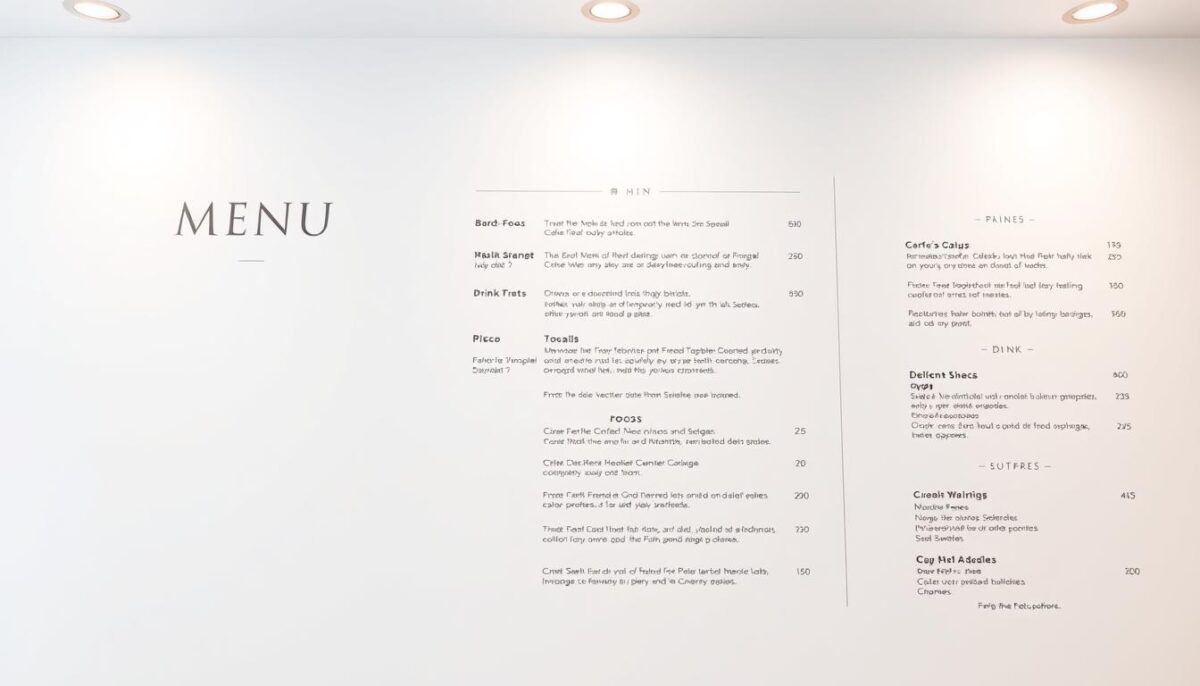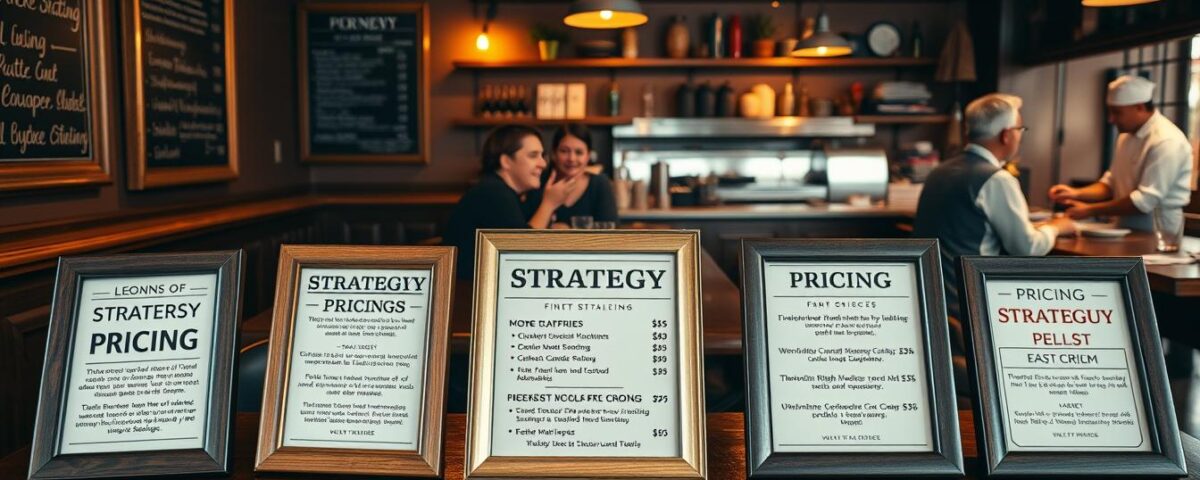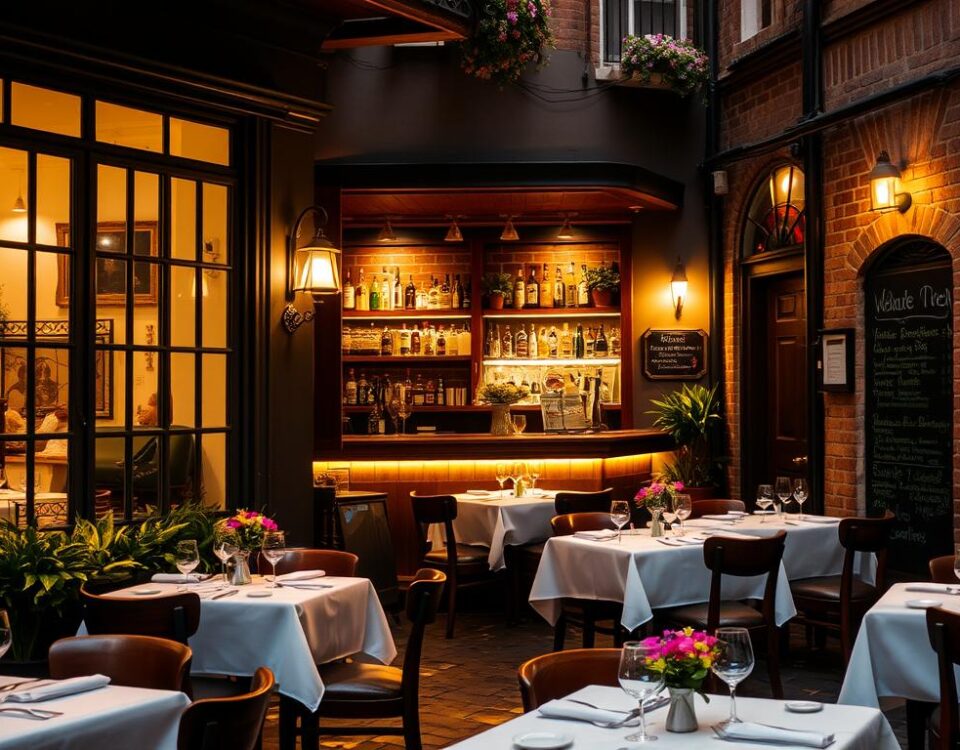
Why the Wrong Colors Could Be Hurting Your Restaurant Sales
July 11, 2025
Why Your Restaurant Might Fail Before Opening — And How to Prevent It
July 12, 2025As a restaurant owner, I’ve faced the daunting task of balancing profitability with customer satisfaction. It’s a delicate dance, especially in today’s economic climate where rising food costs and inflation are squeezing margins. Did you know that a mere 1% increase in menu pricing can lead to a 10% to 15% increase in profits, but if not done correctly, it can also drive customers away?
Strategic menu engineering is not just about raising prices; it’s about understanding the psychology behind how customers perceive value. By applying certain tactics, you can significantly impact your restaurant’s bottom line while keeping your guests happy.
So, how can you achieve this balance? The answer lies in leveraging proven pricing psychology tactics that make your menu more appealing to customers without sacrificing profits.
Key Takeaways
- Understand how customers perceive value on your menu.
- Learn strategic pricing tactics to boost profits.
- Discover how to maintain customer satisfaction while increasing prices.
- Explore the psychology behind effective menu engineering.
- Apply research-backed strategies to your restaurant operations.
The Power of Restaurant Pricing Psychology
Understanding the psychology behind restaurant pricing can be a game-changer for increasing profits. Restaurant pricing psychology is the study of how menu organization and pricing strategies affect customer spending behavior.
What Is Restaurant Pricing Psychology?
Restaurant pricing psychology involves the strategic application of psychological principles to menu pricing and presentation to influence customer purchasing decisions. It’s about understanding how our brains process pricing information and why certain price presentations can trigger different spending behaviors.
The science behind pricing psychology includes concepts like price anchoring, decoy pricing, and the paradox of choice. By applying these principles, restaurants can create menus that prompt customers to choose their order immediately without considering the price.
Why Pricing Psychology Matters for Your Bottom Line
Effective pricing psychology can directly impact a restaurant’s bottom line by increasing average check size and steering customers toward high-margin items. Even small changes in menu presentation can lead to significant revenue increases.
Pricing psychology isn’t about tricking customers but about presenting options in ways that help them make decisions while also benefiting the restaurant. In today’s competitive restaurant landscape, where customers have endless dining options, pricing psychology matters more than ever.
By understanding and applying the principles of pricing psychology, restaurants can create a value proposition that attracts customers and drives sales, ultimately benefiting the restaurant’s bottom line and saving customers money.
Understanding Your Menu’s Current Performance
To maximize profits, you need to have a clear picture of your menu’s current performance. This involves a thorough analysis of your menu items to determine their profitability and popularity.
Analyzing Your Menu Items’ Profitability
Analyzing the profitability of your menu items is crucial for understanding which items are driving profits and which are not. To do this, you need to calculate the food cost percentage and contribution margin for each menu item. The food cost percentage is calculated by dividing the cost of the ingredients by the selling price of the dish. The contribution margin is the selling price minus the food cost. By analyzing these metrics, you can determine the profitability of each menu item.
- Calculate food cost percentage for each menu item.
- Determine the contribution margin for each item.
- Analyze sales data to identify popular items.

Identifying Your Menu’s Stars, Plowhorses, Puzzles, and Dogs
Once you have analyzed the profitability of your menu items, you can categorize them into four categories: Stars, Plowhorses, Puzzles, and Dogs. Stars are high-profitability and high-popularity items. Plowhorses are low-profitability but high-popularity items. Puzzles are high-profitability but low-popularity items. Dogs are low-profitability and low-popularity items. By understanding which category your menu items fall into, you can make informed decisions about pricing, menu engineering, and inventory management.
- Identify your menu’s Stars and consider promoting them.
- Reconsider or reprice Plowhorses to improve profitability.
- Analyze Puzzles to understand why they are not selling well.
- Consider removing or replacing Dogs with more profitable items.
The Menu Matrix: Your Secret Weapon
Unlock the full potential of your menu with the menu matrix, a powerful tool that reveals the hidden dynamics of your menu items. The menu matrix is a method of categorizing menu items based on their profitability and popularity, providing a detailed breakdown that helps you understand how to increase sales and reduce food waste.
How to Create Your Own Menu Matrix
Creating a menu matrix involves several steps. First, gather sales data from your POS system to determine the profitability and popularity of each menu item. Then, plot each item on a matrix using the X-axis for profitability and the Y-axis for popularity. This visual representation will help you identify your menu’s stars, plowhorses, puzzles, and dogs.
- Gather sales data from your POS system.
- Calculate the profitability and popularity of each menu item.
- Plot each item on the matrix.
- Analyze the results to identify areas for improvement.
Using Data to Make Strategic Pricing Decisions
The menu matrix provides valuable insights that can inform your pricing strategy. By analyzing the profitability and popularity of your menu items, you can make data-driven decisions about pricing, promotion, and menu design. For instance, you might consider increasing prices for highly popular but less profitable items or promoting less popular but highly profitable items to boost sales.
Key benefits of using the menu matrix include:
- Identifying opportunities for menu optimization.
- Making data-driven decisions about pricing and promotion.
- Improving profitability by focusing on high-margin items.
By regularly updating your menu matrix, you can ensure that your menu remains optimized and aligned with customer preferences and market trends.
Menu Engineering Fundamentals
Menu engineering is both an art and a science that can significantly impact your bottom line. By strategically designing and organizing your menu, you can maximize profits without alienating your customers.
The Golden Triangle: Strategic Item Placement
Studies show that customers are likely to order one of the first items that draw their attention. Since guests only spend an average of 109 seconds looking at your menu, it must be designed for guests to easily find key items. The concept of the “Golden Triangle” refers to the areas of a menu that naturally draw the customer’s eye first: the top right corner, top left corner, and center. Placing your most profitable items in these areas can significantly boost sales.

To effectively utilize the Golden Triangle, consider the layout of your menu. Place your most profitable items in the center, top right, and top left corners. This strategic placement can help guide your customers’ choices and increase the average order value.
Highlighting Your Most Profitable Items
Once you’ve placed your profitable items in the Golden Triangle, it’s essential to highlight them using various design elements. You can use white space, boxes, fonts, and colors to draw attention to these items without making your menu look cluttered. Descriptive language can also play a crucial role in making your dishes more appealing. For instance, instead of simply listing “Grilled Chicken,” you could describe it as “Tender Grilled Chicken Breast served with a side of our signature BBQ sauce.”
| Design Element | Purpose | Example |
|---|---|---|
| White Space | Reduces clutter, draws attention | Spacing around high-profit items |
| Boxes and Borders | Highlights specific dishes | A box around a signature dish |
| Fonts and Colors | Creates visual appeal, emphasizes importance | Using a bold font for high-profit items |
Effective menu engineering requires a balance between creativity and data analysis. By understanding your customers’ preferences and behaviors, you can create a menu that is both appealing and profitable. Regularly updating your menu design based on changing costs and seasonal availability can also help keep your offerings fresh and relevant.
5 Core Pricing Strategies for Restaurants
The right pricing strategy can make or break a restaurant, and there are five core approaches to explore. As a restaurant owner, understanding these pricing strategies is crucial to maximizing profits without losing customers.
Cost-Plus Pricing: The Traditional Approach
Cost-plus pricing involves calculating the total costs of a menu item, including ingredient costs, labor, and overheads, and then adding a fixed markup percentage. This traditional approach ensures that all costs are covered, but it may not maximize profit potential.
Value-Based Pricing: What Customers Will Pay
Value-based pricing focuses on what customers perceive as fair value rather than just covering costs. By understanding your customers’ perceived value, you can determine what they are willing to pay, potentially leading to higher margins on signature items.
Competitive Pricing: Positioning Against Rivals
Competitive pricing involves examining your competitors’ price points to determine a baseline that’s acceptable in your niche and region. This approach helps you position your offerings effectively against local rivals without starting destructive price wars.
Price Skimming: Maximizing Profits on Novelty
Price skimming is a tactic where a restaurant introduces novel menu items, leveraging their distinctiveness to command premium price points initially. This approach allows you to maximize profit potential before competitors catch up.
Price Penetration: Building Customer Base
Price penetration involves setting initially lower price points to build a large customer base quickly. This strategy is particularly effective for new restaurants or when launching delivery services, as it attracts customers and drives sales.
In conclusion, each of these five core pricing strategies has its strengths and weaknesses. By understanding your target market and analyzing your competitors, you can determine which strategy or combination of strategies is right for your restaurant.
- Cost-plus pricing ensures all costs are covered but may not maximize profit.
- Value-based pricing focuses on customers’ perceived value, potentially leading to higher margins.
- Competitive pricing helps position your offerings against local rivals.
- Price skimming maximizes profit potential on novel menu items.
- Price penetration builds a large customer base through initially lower price points.
Psychological Pricing Tactics That Drive Orders
To drive orders and increase profitability, restaurants must master the psychological aspects of pricing. Understanding how customers perceive prices and making subtle adjustments can significantly impact sales.
The Power of Price Anchoring
Price anchoring is a powerful tactic that involves placing a higher-priced item next to a more moderately priced one to make the latter seem like a better value. For instance, adding a grilled steak to a salad for $9.99 next to a chicken add-on for $7.99 makes the chicken appear more affordable. Similarly, listing more expensive items at the top of the menu can create the perception that the remaining items are relatively more affordable, leading to increased orders and sales over time.

Decoy Pricing: Making Options More Attractive
Decoy pricing involves introducing a third, more expensive option to make one of your existing options seem more attractive by comparison. By placing a “decoy” menu item near your high-profit margin items, you can make the latter appear more reasonably priced. For example, if you have a high-profit item priced at $15, introducing a decoy item at $25 can make the $15 item seem like a better deal, thus driving sales towards the more profitable item.
- Introduce a decoy item that’s slightly more expensive than your target menu item.
- Place the decoy item next to or near the target item on the menu.
- Ensure the decoy item is not so expensive that it deters customers but enough to make your target item seem like a good value.
Creating a Sense of Scarcity and Urgency
Creating a sense of scarcity and urgency around certain menu items can also drive orders. Techniques include limited-time offers, daily specials, and “while supplies last” messaging. These tactics tap into fundamental human decision-making processes, encouraging customers to order more quickly rather than deliberating.
By implementing these psychological pricing tactics—price anchoring, decoy pricing, and creating a sense of scarcity—restaurants can subtly influence customer ordering decisions, driving sales and increasing profitability without being manipulative.
Menu Design Elements That Influence Spending
Your menu’s design is more than just aesthetics; it’s a powerful tool to drive sales. The visual elements of your menu can significantly impact customer spending habits beyond just the prices themselves.
Strategic Use of Colors and Fonts
The colors and fonts used on your menu can evoke different emotional responses and appetites. To capture attention and trigger appetite, use bright colors like red, yellow, and orange strategically. For instance, you can use these colors to attract attention to specific areas of your menu and create a hierarchy for the layout. Match your color scheme to your restaurant’s theme to reinforce associations; for example, use light blue for a seafood restaurant, and green and tan for a farm-to-table restaurant.
The Art of Menu Descriptions
Well-crafted menu descriptions can engage multiple senses and create desire, moving beyond basic ingredient lists. To achieve this, use adjectives that increase perceived value without sounding pretentious. For example, instead of saying “grilled chicken,” say “tender, slow-grilled chicken breast.” This technique can make your dishes sound more appealing and enhance the overall dining experience.
Photos: When and How to Use Them
Using photos on your menu can be effective, but it’s crucial to use them sparingly. Excessive photos are often associated with low-end venues, so high-end restaurants usually avoid them. However, one photo per page has been shown to increase sales by up to 30%, especially at casual eateries. Consider using your Instagram and Facebook pages to share more photos of your food.
Price Presentation Techniques
The way prices are presented on a menu can significantly influence customer perception and spending habits. Effective price presentation techniques can enhance the dining experience and increase profitability.
Removing Dollar Signs and Decimals
One simple yet effective technique is removing dollar signs from menu prices. This reduces “price pain” by making customers less aware of the cost. Research has shown that menus without dollar signs can lead to increased average check sizes. Additionally, omitting decimals can make prices appear cleaner and more appealing.
Avoiding Price Trails and Columns
Price trails, or dotted lines leading to prices, can distract from menu descriptions and focus attention on the cost rather than the dish. Similarly, listing prices in columns can facilitate easy comparison and encourage customers to opt for the cheapest item. Instead, integrating prices seamlessly into menu descriptions can enhance the overall dining experience.
The Psychology of Number Endings
The ending of a price can have psychological implications. Prices ending in .99 can appear gimmicky, while rounded numbers can convey a sense of quality. Understanding the psychology behind number endings can help restaurateurs make informed pricing decisions that appeal to their target audience.
| Pricing Technique | Effect on Customers |
|---|---|
| Removing Dollar Signs | Reduces “price pain” |
| Avoiding Price Trails | Focuses on dish descriptions |
| Rounded Number Endings | Conveys quality |
Bundling and Promotion Strategies
Effective bundling and promotion strategies can significantly boost restaurant sales and enhance customer value. By combining menu items in appealing ways and creating limited-time offers, restaurants can drive revenue and improve customer satisfaction.
Creating Profitable Meal Bundles
Creating profitable meal bundles involves strategically pairing high-margin menu items with complementary items at a discounted price. This approach not only increases the average order value but also enhances the perceived value for customers. For instance, fast-food giants like McDonald’s and Burger King bundle burgers, fries, and drinks, making the combo more attractive than buying individual items. To create successful bundles, restaurants should focus on highlighting their most profitable menu item while including lower-cost additions that complement the main dish.
Limited-Time Offers That Drive Sales
Limited-time offers (LTOs) are a powerful tool for driving immediate sales and creating a sense of urgency among customers. By leveraging seasonal ingredients, holidays, or special events, restaurants can create LTOs that attract new customers and encourage repeat business. For example, holiday dinner promotions or discounted price on specific weekend nights can boost sales during typically slower periods. To maximize the impact, restaurants should promote their LTOs through various marketing channels, ensuring that the offers are visible and appealing to their target audience. By doing so, restaurants can increase profit while maintaining a strong brand image.
Implementing Changes Without Alienating Guests
Implementing pricing changes in a restaurant setting requires a delicate balance between increasing revenue and preserving customer loyalty. When adjusting menu prices, it’s crucial to consider the potential impact on your customers and the overall dining experience.
Gradual Price Increases vs. Menu Overhauls
When deciding how to adjust your menu pricing, you have two primary options: gradual price increases or a complete menu overhaul. Gradual increases can help minimize customer backlash by spreading out the changes over time. On the other hand, a complete menu overhaul can be an opportunity to rebrand and reposition your restaurant, but it carries a higher risk of alienating loyal customers. The best approach depends on your restaurant’s current situation and customer expectations.
Training Staff to Support Your Pricing Strategy
Your staff plays a vital role in supporting your pricing strategy through their interactions with guests. To ensure a smooth transition, it’s essential to provide comprehensive training on the new menu and pricing structure. This includes educating servers on how to confidently explain price changes and upsell high-profit items without appearing pushy. By empowering your staff with the knowledge and skills they need, you can maintain customer satisfaction while implementing necessary changes to your menu and pricing.
Conclusion: Balancing Profitability and Customer Satisfaction
The key to successful restaurant pricing lies in understanding the psychological factors that influence customer purchasing decisions. Throughout this article, we’ve explored various menu engineering and pricing psychology tactics that can help restaurants increase profits without alienating their guests.
By strategically applying techniques such as price anchoring, decoy pricing, and creating a sense of scarcity, you can drive sales and enhance customer value. It’s essential to remember that effective pricing isn’t about charging the highest possible prices; it’s about finding the sweet spot where profit increases while customers still feel they’re receiving good value.
Menu engineering and pricing psychology should be ongoing processes, with continuous monitoring of financial metrics and customer feedback. Different tactics will work better for different restaurant concepts, so it’s crucial to experiment and find what works best for your unique situation. By implementing these strategies and maintaining a focus on quality and authenticity, you can achieve long-term success and improve customer satisfaction, ultimately leading to increased profit and a loyal customer base.
Start implementing these tactics today, and watch your restaurant thrive as you strike the perfect balance between profitability and customer satisfaction, keeping your guests happy and your business growing.
FAQ
How can I increase sales without losing customers when adjusting my menu prices?
To boost sales without alienating your customers, consider implementing a value-based pricing strategy that focuses on the perceived value of your dishes. You can also create limited-time offers or meal bundles that provide customers with a sense of urgency and value.
What is the best way to analyze my menu items’ profitability?
To analyze your menu items’ profitability, you need to understand the cost of each dish, including the cost of ingredients, labor, and overheads. You can then use a menu matrix to categorize your menu items based on their profitability and popularity.
How do I decide which menu items to highlight or remove?
To decide which menu items to highlight or remove, you need to identify your menu stars, plowhorses, puzzles, and dogs. Menu stars are profitable and popular, while dogs are unprofitable and unpopular. Consider removing or reengineering menu dogs to improve overall profitability.
What is price anchoring, and how can I use it effectively?
Price anchoring is a technique where you display a higher price next to a lower price to make the lower price appear more reasonable. You can use price anchoring by displaying a premium version of a dish next to a standard version, making the standard version appear more affordable.
How can I train my staff to support my new pricing strategy?
To train your staff to support your new pricing strategy, you need to educate them on the reasoning behind the changes and provide them with the skills to effectively communicate the value of your menu items to customers. This can include training on menu engineering and price presentation techniques.
What are some common mistakes to avoid when implementing a new pricing strategy?
Common mistakes to avoid when implementing a new pricing strategy include making sudden and drastic changes, failing to communicate the value of menu items to customers, and not monitoring the impact of the changes on customer behavior and sales.



